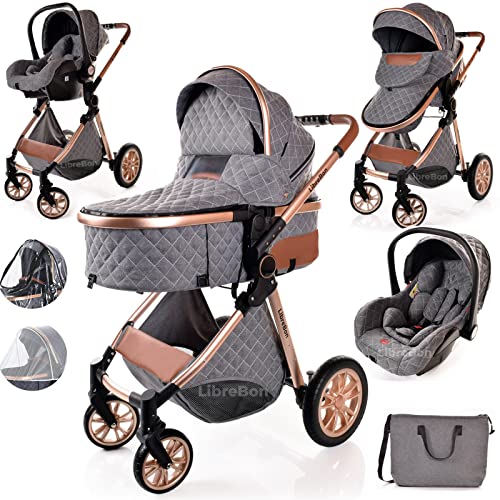Pram vs. Pushchair: Understanding the Key Differences
When it pertains to carrying babies and young kids, moms and dads typically discover themselves overwhelmed by the numerous alternatives offered. Amongst updated blog post , prams and pushchairs are 2 of the most common forms of baby transportation. While the terms are typically utilized interchangeably, each has distinct features and benefits that deal with diverse parenting needs. In this short article, we will explore the fundamental differences between prams and pushchairs, helping moms and dads make notified choices about which is best suited for their household.
What is a Pram?
A pram, or perambulator, is a type of baby carriage developed mostly for newborns and babies. Prams normally include a completely flat lying position, which is important for newborns who require to lie flat for spine development. Most prams come equipped with a deep, enclosed body that offers a cozy and safe and secure environment for the baby, frequently with additional features such as hoods or covers to protect them from the aspects.
Key Characteristics of Prams:
- Flat Lying Position: Supports healthy back development in newborns.
- Enclosed Design: Protects the baby from wind and sunlight.
- Traditional Aesthetic: Often made from materials like wicker or fabric, providing a traditional look.
- Weight and Bulkiness: Generally heavier and bulkier than pushchairs.
What is a Pushchair?
A pushchair, also called a stroller or buggy, is designed for older babies and toddlers who can sit up unassisted. Pushchairs permit numerous seating positions, consisting of reclining options for naptime. They are usually lighter and more agile than prams, allowing parents to navigate busy areas with ease. Numerous pushchairs include adjustable deals with, storage compartments, and can typically be folded for hassle-free transportation.
Key Characteristics of Pushchairs:
- Seating Position: Designed for children who can sit up, with different reclining positions.
- Light-weight and Compact: Easier to maneuver and transportation.
- Adaptability: Many designs are convertibles or can accommodate safety seat.
- Storage Features: Often consist of baskets for carrying diaper bags, toys, etc.
Secret Differences Between Prams and Pushchairs
Below is a relative table highlighting the critical distinctions between prams and pushchairs.
| Function | Pram | Pushchair |
|---|---|---|
| Target Age | Newborns to 6 months (flat position required) | 6 months to toddler age (sitting unassisted) |
| Design | Enclosed, traditional design | Open, contemporary style |
| Weight | Heavier, bulkier | Lighter, more compact |
| Seating Options | Flat only | Numerous positions including reclining |
| Manoeuvrability | Less maneuverable due to weight | Highly maneuverable |
| Storage Space | Restricted | Generous below baskets |
Selecting Between a Pram and a Pushchair
Consideration Factors:
- Age of the Child: Choose a pram for newborns and a pushchair for older infants and young children.
- Meant Use: If you plan to do a lot of walking or navigating city streets, consider a design that matches your lifestyle.
- Space: Assess the available storage in your house or vehicle and how compactly a model can fold.
- Budget: Consider the rate variety, as prams and pushchairs can differ extensively in cost.
- Features: Look for additional functions that may be advantageous for your day-to-day life, such as cup holders, canopies, or simple folding systems.
Advantages and Disadvantages
Advantages of Prams
- Perfect for Newborns: Encourages healthy spinal column development.
- Comfortable Space: Provides a comfortable environment for babies.
Downsides of Prams
- Weight: Heavier and bulkier, making them less useful for daily use.
- Restricted Use Time: Generally helpful just for the first 6 months.
Benefits of Pushchairs
- Flexibility: Suitable for longer periods as the child grows.
- Lightweight Design: Easier to carry and maneuver.
Drawbacks of Pushchairs
- Not Suitable for Newborns: Requires the child to be able to stay up unassisted.
- Less Protective: Generally more exposed than a pram.
Regularly Asked Questions (FAQs)
1. Can I utilize a pushchair for a newborn?
A lot of pushchairs are not developed for newborns; however, many models come with infant safety seat adapters. Some pushchairs use a totally reclining seat option that may be suitable for infants, however make sure the maker validates it's safe.
2. Which is much better for travel?
Pushchairs are typically chosen for travel due to their light-weight and compact nature. They can typically be folded quickly for transportation on public transport and fit more easily in car trunks.
3. For how long can I utilize a pram?
Prams are typically suitable for babies until they reach around 6 months of age or when they can support themselves in a seated position.
4. Are there hybrid designs available?
Yes, lots of producers produce hybrid designs that can be converted from a pram to a pushchair depending upon the child's development stage.
5. What should I try to find when purchasing a pram or pushchair?
When acquiring, think about safety functions, ease of usage, sturdiness, weight, and storage. It's likewise a good idea to check different models for comfort before deciding.
Choosing in between a pram and a pushchair eventually depends upon the age of your child and your lifestyle preferences. Understanding their differences assists moms and dads make notified choices that deal with their household's requirements. Parents can take pleasure in the journey of parenthood by ensuring that their kid's convenience and security are constantly focused on, while also considering their own convenience and style.

